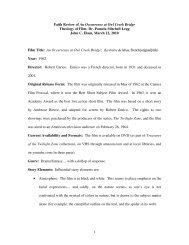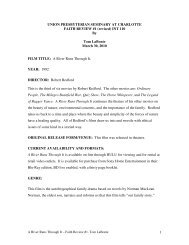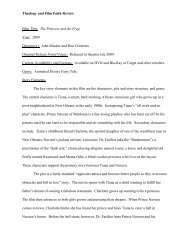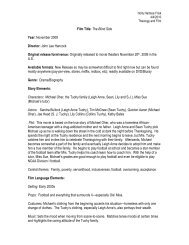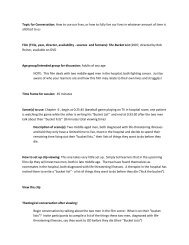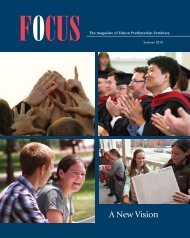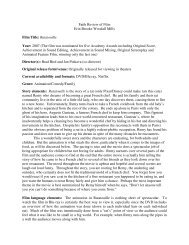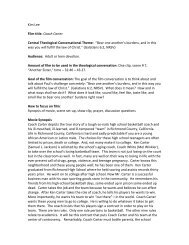Create successful ePaper yourself
Turn your PDF publications into a flip-book with our unique Google optimized e-Paper software.
FILM TITLE<br />
FAITH REVIEW OF FILM<br />
<strong>The</strong> <strong>Freedom</strong> <strong>Writers</strong><br />
Frank Cunningham<br />
YEAR<br />
DIRECTOR(S)<br />
RICHARD LaGRAVENESE<br />
ORIGINAL RELEASE FORM /<br />
VENUE<br />
CURRENTLY AVAILABLE<br />
FORMATS<br />
GENRE<br />
STORY ELEMENTS<br />
2007 – Released January 5, 2007 in USA<br />
RICHARD LaGRAVENESE: who also wrote the screenplay. Currently screenplay<br />
writer for <strong>The</strong> Chronicles of Narnia: <strong>The</strong> Voyage of the Dawn Treader (2010 – in<br />
post production).<br />
PAST WORKS: As writer: <strong>Freedom</strong> <strong>Writers</strong> (2007), P.S. I Love You (2007), Paris,<br />
je t'aime (2006) (segment "Pigalle") aka Paris, I Love You, Beloved (1998/I), Living<br />
Out Loud (1998), <strong>The</strong> Horse Whisperer (1998), <strong>The</strong> Mirror Has Two Faces (1996),<br />
Unstrung Heroes (1995), <strong>The</strong> Bridges of Madison County (1995), A Little Princess<br />
(1995), <strong>The</strong> Ref (1994) aka Hostile Hostages, <strong>The</strong> Fisher King (1991), Rude<br />
Awakening (1989). As director: P.S. I Love You (2007), <strong>Freedom</strong> <strong>Writers</strong> (2007),<br />
Paris, je t'aime (2006) (segment "Pigalle") aka Paris, I Love You, A Decade Under<br />
the Influence (2003), Living Out Loud (1998). As producer: A Decade Under the<br />
Influence (2003), <strong>The</strong> Ref (1994) aka Hostile Hostages<br />
Released in theatres in the US in January 2007. <strong>The</strong>atrical releases staggered in<br />
24 other countries from February to September 2007<br />
DVD, DVD HD, BLUERAY, VHS<br />
Biography / Drama / True Story<br />
PRINCIPAL CHARACTERS:<br />
Erin Gruwell: Teacher<br />
Scott Casey, Gruwell’s husband<br />
Steve Gruwell, Erin’s Father<br />
Margaret Campbell, Erin’s supervisor<br />
Students<br />
ACTORS & ACTING:<br />
Hilary Swank as Erin Gruwell<br />
Patrick Dempsey as Scott Casey<br />
Scott Glenn as Steve Gruwell<br />
Imelda Staunton as Margaret Campbell<br />
ATMOSPHERE<br />
<strong>The</strong> backdrop against which the story develops is an inner city culture of<br />
drive-by shootings, gang violence, riots, separation of races and ethnicity and<br />
an uncaring educational system.
POINT OF VIEW<br />
<strong>The</strong> point of view is from the perspective of the new teacher, Erin Gruwell,<br />
who finds herself in a school having issues of racism and violence. While her<br />
point of view carries through the movie, there are interlaced diversions to<br />
points of view of her students. <strong>The</strong>se shifts are effortless and purposeful.<br />
<strong>The</strong>y allow the viewers glimpses into the world of each of the students.<br />
PLOT<br />
Based on a true story, Swank as Erin Gruwell begins her teaching career as a<br />
freshman English teacher in Woodrow Wilson High School in Long Beach,<br />
California. <strong>The</strong> school is voluntarily integrated, and it isn't working. <strong>The</strong><br />
Asians, the Blacks, the Latinos, and a very few whites not only don't get along,<br />
but also stay with their own and are part of protective and violent gangs.<br />
<strong>The</strong>re isn't much teaching or learning going on at the school. It is a warehouse<br />
for young teenagers until they can drop out or are kicked out. Gruwell enters<br />
as a new teacher having a middle class, well educated idealist background.<br />
She quickly realizes that the school system is uncaring and has given up on<br />
these teens as “unteachable.” Gruwell battles the uncaring system, a<br />
husband who is jealous of her time commitments, and a father who expresses<br />
his disappointment in her career choice. Gruwell brings not just education<br />
but a new sense of hope to her students as well as a new found purpose to<br />
their lives.<br />
PACING<br />
Intentionally, the pacing of the film varies. <strong>The</strong> normally slower pacing is<br />
accented with a fast pace during the scenes of violence and conflict.<br />
FILM LANGUAGE<br />
ELEMENTS<br />
CENTRAL THEMES<br />
Discrimination, racism, intolerance moves to finding commonality, rising<br />
above the issues, and commitment of and to change.<br />
SETTING<br />
A contemporary setting in a high school and in the community of Long Beach,<br />
California<br />
STAGING<br />
Take note of the lack of integration. Just like in the community, each race<br />
divides itself off from other groups and races. This is noted on school grounds<br />
and in the classroom where students move their desks and select seat<br />
locations based on race.<br />
CAMERA SHOTS AND ANGLES<br />
Camera angles are key to the telling of the story in terms of the<br />
communication going on between the teacher and students. <strong>The</strong> shots of the<br />
teacher are from the position of the sitting student and the student shots are<br />
from the point of view of the standing teacher.
EDITING<br />
<strong>The</strong> movie was edited into a tight moving story. Some of the deleted scenes<br />
are included in the DVD under the “Deleted Scenes” icon. Two deleted scenes<br />
that would be a good opener for discussions are the class attending a showing<br />
of the movie “Schindler’s List” and the follow on scene of having dinner<br />
together in an upscale restaurant.<br />
MUSIC<br />
An attention grabber at the beginning and ending of the movie is a hip-hop<br />
song written and recorded for the movie. <strong>The</strong> songwriters used a strong hiphop<br />
beat with the intermix of segments of Martin Luther King’s “I Have A<br />
Dream” speech. Throughout the movie street music is used in transitioning<br />
between scenes and themes.<br />
AUDIENCE / CULTURAL<br />
CONTEXT ELEMENTS<br />
INTENDED VIEWERS<br />
This is a movie that is intended to inform. It reaches out to those most like<br />
the students, telling them that there is a way out. It reaches educators and<br />
education administrators with insights about the condition of and one answer<br />
to giving up on students. And it reaches parents and students and<br />
communities without the level and extent of hardships faced by these inner<br />
city students. It teaches that one person can make a difference.<br />
ATTITUDE TOWARDS AUDIENCE<br />
<strong>The</strong> film believes that everyone watching can relate to it. An important<br />
message is being shared even though it will have variations of meaning<br />
depending upon the background of the audience members watching.<br />
SOCIAL, ECONOMIC, PSYCHOLOGICAL CONTEXT<br />
This is the element that drives the film. Contrasting “haves” from those who<br />
are the “have nots” of society, we are given the chance to look at ourselves<br />
and the groups we have isolated ourselves within. <strong>The</strong> level of violence<br />
experienced by these children was never realized in where and how I live. But<br />
the degree of indifference and the degree of giving up on a class of people<br />
runs rampant here and everywhere just as much as it did in Long Beach,<br />
California.<br />
THEOLOGY IS FOUND<br />
RELATIONSHIP OF FILM TO CULTURE<br />
<strong>The</strong> film captures a broken segment of our culture that is not pretty. While<br />
these inner city students faced violence and other real concerns of safety,<br />
they also faced an education system that dedicated little if any resources or<br />
caring. <strong>The</strong>se were students without hope. While issues of violence may not<br />
be equated, there still remain segments of our population who are without<br />
hope. This film helps us to see those segments closest to us.<br />
<strong>The</strong>ology is found indirectly in and outside of this film. <strong>The</strong>ology of the highest<br />
commandment of loving others as yourself is modeled by teacher Gruwell. In<br />
very broad and general terms, the film opens up questions about human being,<br />
community and sinfulness. Outside of the film, discussion can focus on the nature<br />
of the groups and communities found in the film and how they might be related
THEOLOGICAL THEMES<br />
FOR CONVERSATION<br />
SUGGESTED TYPE OF<br />
CONVERSATION<br />
RECOMMENDED WAYS TO<br />
VIEW AND ENGAGE THE<br />
FILM<br />
CONCLUDING OR<br />
SUMMARY REMARKS<br />
theologically to the groups and communities of which we are a part.<br />
Hope: How does God instill hope in each of us? Where have we seen division<br />
and isolation resulting in people being treated differently? Do you know<br />
someone who has lost hope? As God’s people, how are we to respond to<br />
others whose hope is lost? Is there a difference in your mind between<br />
knowing what you are supposed to do and what you are willing to do? Why?<br />
Love: What does it mean to have agape love? How does that form of love fit<br />
in with “<strong>The</strong> <strong>Freedom</strong> <strong>Writers</strong>?” Do we turn away from others? How? What<br />
would Christ say of that?<br />
Church: Why is it that most churches today are segregated? Are these<br />
examples of the same groups we see in the movie? Like the students who<br />
moved their desks around, have we built barriers around us? Living into the<br />
life of Christ, how should we respond?<br />
Broken Human Condition: In the discussion phase, list all of the brokenness<br />
found in the film. Note who is broken and how are they broken.<br />
Christ: Can one make a difference? What elements do we see that might<br />
cause us to consider Gruwell a Christ figure?<br />
I see the film as a critical challenge in some respects and for deepening of the<br />
theological themes in other respects.<br />
View the film in its totality, watching it together and converse immediately<br />
thereafter.<br />
<strong>The</strong> security guard breaking up the first fight in the classroom is the actual<br />
<strong>Freedom</strong> Writer who was the subject of the vulgar cartoon passed around in<br />
class.<br />
<strong>The</strong> young man playing the video game machine in the convenience store was<br />
killed just weeks after the movie was shot. A gang member wanted his<br />
skateboard chain and shot him when he refused to give it to him.<br />
Rated PG-13: some vulgar language, violence including drive-by shooting, riot<br />
video, school fight, and domestic violence scene.<br />
www.freedomwritersfoundation.org<br />
REVIEW COMPLETED BY Frank Cunningham – February 15, 2010



